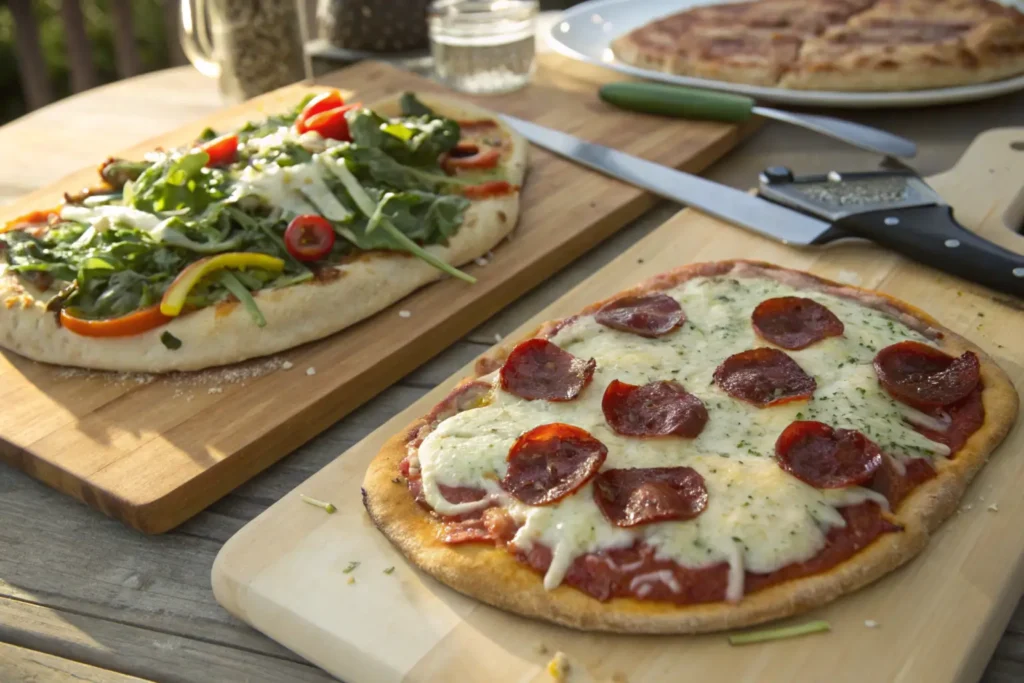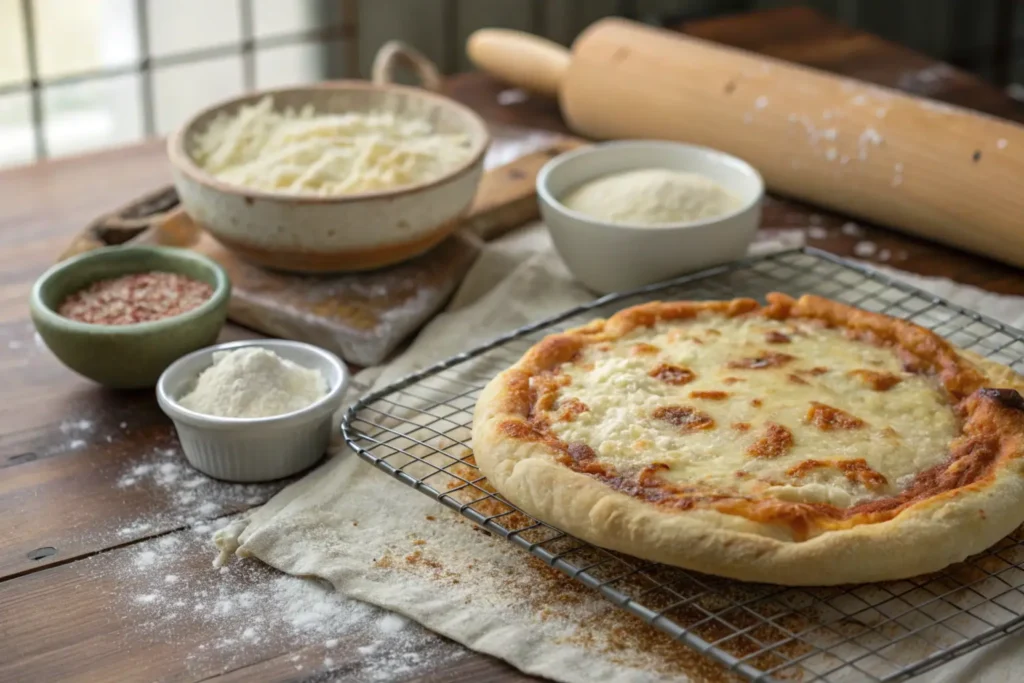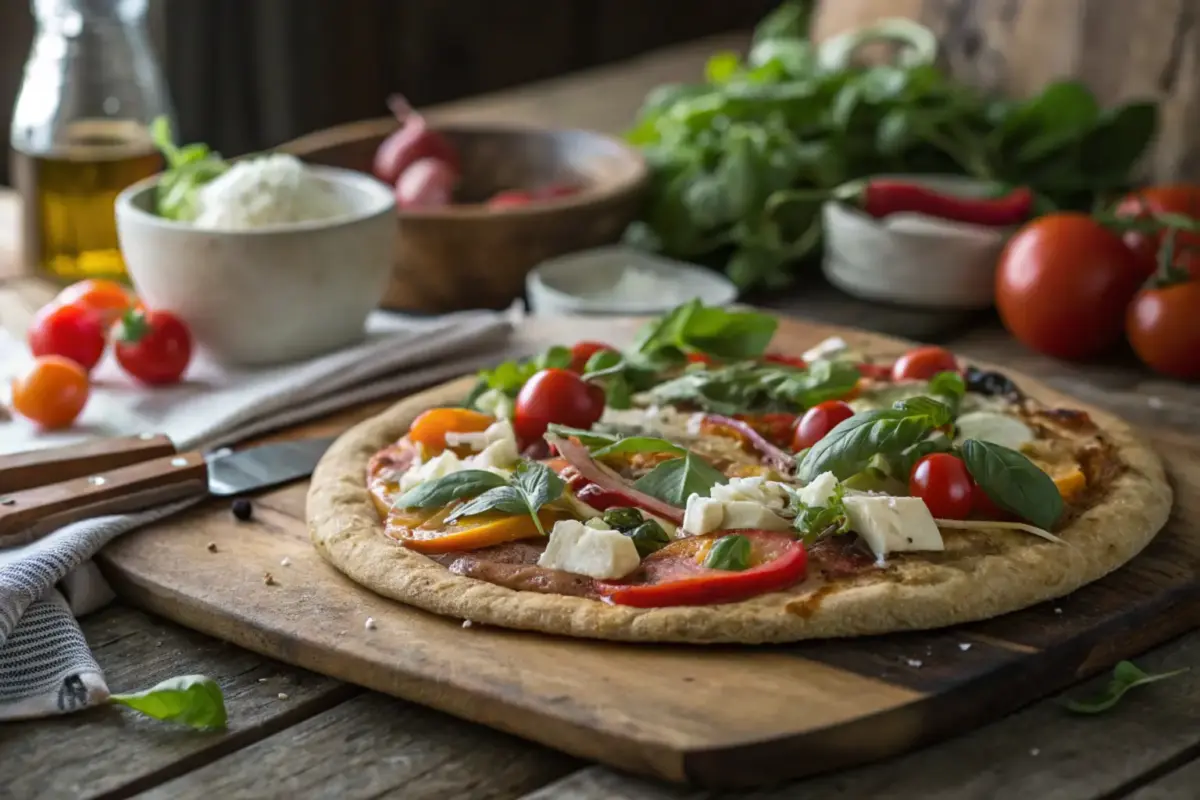Introduction
Let’s be honest, pizza is the ultimate comfort food. Whether it’s a Friday night treat or a quick meal fix, it always hits the spot. But if you’re looking to make healthier choices, the crust is a great place to start. The right crust can turn a guilty pleasure into a balanced meal without sacrificing flavor. In this guide, we’ll break down the options and help you pick the healthiest crust for your next pizza night.
Understanding Pizza Crust and Its Nutritional Impact
The Role of Ingredients in Determining Health
The ingredients used in pizza crust are the foundation of its nutritional profile. Traditional crusts are usually made with refined white flour, which is high in carbohydrates but low in fiber and essential nutrients. This can lead to energy spikes (and crashes) after eating. Adding whole grains, vegetables, or protein-rich ingredients can change the game, making your crust more nutritious and satisfying. For example, exploring the possibility of using cottage cheese in your pizza crust can add an unexpected nutritional twist.
Common Types of Pizza Crust
When you think of pizza, you probably picture the classic hand-tossed crust. But there are so many more to consider! Here’s a quick rundown:
- Classic white flour crust: Light and fluffy, but not the most nutrient-dense choice.
- Whole wheat crust: A fiber-rich option with a hearty flavor.
- Cauliflower crust: Popular for its low-carb appeal.
- Thin crust: Crisp and lower in calories compared to thicker varieties.
- Deep dish: Packed with carbs and calories—great for indulgence, less so for health.
Understanding the basics helps set the stage for making informed choices, so let’s dive deeper into the healthier alternatives.
Whole Wheat Crust: A Nutritious Alternative
Benefits of Whole Wheat Flour in Pizza
Whole wheat crusts are a fan favorite for good reason. They’re packed with fiber, which supports digestion and helps you feel fuller longer. Plus, whole wheat flour contains more vitamins and minerals than its refined counterpart, including iron, magnesium, and B vitamins. It’s a simple swap that can significantly boost the nutritional value of your pizza.
How to Make a Whole Wheat Crust
If you’ve never made pizza dough from scratch, don’t worry—it’s easier than you think. Start with whole wheat flour, yeast, a pinch of salt, a little olive oil, and warm water. Mix everything, knead the dough until it’s smooth, and let it rise for about an hour. Roll it out, top it with your favorite ingredients, and bake. Pro tip: Adding a touch of honey to the dough balances the earthy flavor of whole wheat flour and gives the crust a nice golden color.
Cauliflower Crust: A Low-Carb Option
Nutritional Advantages of Cauliflower Crust
If you’re cutting carbs or gluten, cauliflower crust is a lifesaver. Made by blending cauliflower with eggs, cheese, and seasonings, this crust is low in calories and rich in nutrients like vitamin C and potassium. For those considering unique alternatives, you might want to try a cottage cheese-based crust for added protein and a creamy texture.
Ideal for Gluten-Free and Keto Diets
Cauliflower crust fits perfectly into gluten-free and keto lifestyles. Because it’s naturally low in carbs, it’s a go-to for anyone keeping an eye on their carb intake. Plus, it’s easy to find pre-made cauliflower crusts at most grocery stores if you’re short on time. Just keep an eye on the ingredients list to make sure it’s not loaded with unnecessary fillers or preservatives.
Thin Crust vs. Deep Dish: Which is Healthier?

Comparing Calorie and Carbohydrate Content
When it comes to calorie and carb counts, thin crust is the clear winner. It uses less dough, which means fewer calories and carbohydrates per slice. Deep dish, while undeniably delicious, can pack in double or even triple the calories due to its thick, doughy base. If you’re watching your intake, sticking to thin crust is a smart move.
Portion Control and Serving Sizes
Let’s face it, the size of your slice matters. With thin crust, you’re more likely to stick to a reasonable portion size because it feels lighter. Deep dish, on the other hand, can be so filling that it’s easy to overdo it. If you’re going for deep dish, try serving smaller slices and pairing them with a fresh salad to keep things balanced.
Sourdough Crust: A Gut-Healthy Choice

Benefits of Fermentation in Pizza Dough
Sourdough crust has been making a big comeback, and for good reason. The fermentation process used to make sourdough dough is not just about flavor—it’s also great for your gut. Fermented dough contains probiotics, which can support digestion and gut health. It also has a slightly tangy flavor that pairs beautifully with savory pizza toppings.
Sourdough vs. Traditional Crusts
Unlike traditional crusts made with commercial yeast, sourdough crust rises naturally thanks to wild yeast and lactic acid bacteria. This slow fermentation process makes the crust easier to digest for many people, especially those who find regular pizza a little too heavy. While sourdough takes longer to prepare, the health benefits and flavor are totally worth the extra effort.
Gluten-Free Crusts: For Sensitivities and Allergies
Exploring Gluten-Free Flour Options
For anyone with gluten sensitivities or celiac disease, gluten-free crusts are a must. The good news is there are plenty of flour options to choose from, including almond flour, rice flour, and chickpea flour. Each one brings its own unique flavor and texture to the table. Prebaking the crust, much like prebaking quiche crusts, ensures a firm base that supports all your delicious toppings.
Tips for Baking Gluten-Free Pizza
Baking gluten-free crusts can be tricky since they don’t have the same elasticity as wheat-based dough. To get the right consistency, you might need to mix a few different flours together or add a binder like xanthan gum. Don’t skip pre-baking the crust before adding toppings—it helps ensure a firm base that won’t fall apart when you slice into it.
Vegan Crust Options: Plant-Based and Healthy
Common Ingredients in Vegan Crusts
Vegan crusts skip the eggs and dairy, focusing instead on plant-based ingredients. You’ll often see recipes that use olive oil, plant-based milk, and flours like whole wheat or spelt. Some even incorporate mashed sweet potatoes or zucchini for added nutrients and moisture.
How to Ensure Nutritional Balance
To make a vegan crust that’s both tasty and nutritious, balance is key. Use whole-grain flours for fiber and nutrients, and avoid overloading the dough with oil or sugar. Pair it with fresh, plant-based toppings like roasted vegetables, arugula, and a sprinkle of nutritional yeast for a cheesy flavor without the dairy.
High-Protein Crusts: Boosting Nutritional Value
Protein-Rich Ingredients for Pizza Dough
If you’re looking for a crust that supports an active lifestyle, high-protein options are a great choice. Ingredients like almond flour, chickpea flour, and even protein powder can be added to the dough for a protein boost. These crusts are perfect for post-workout meals or whenever you need a little extra fuel.
Ideal for Active Lifestyles and Fitness Enthusiasts
High-protein crusts aren’t just about nutrition—they’re also super filling, which helps with portion control. They’re especially popular with fitness enthusiasts and anyone following a high-protein diet. Add lean protein toppings like grilled chicken or tofu, and you’ve got a pizza that’s as satisfying as it is healthy.
Exploring Innovative and Exotic Crusts
Quinoa Crust: A Superfood Base
Quinoa is often called a superfood, and it’s easy to see why. It’s packed with protein, fiber, and essential amino acids. When blended and baked, quinoa creates a crisp yet chewy crust that works beautifully as a base for pizza. It’s also naturally gluten-free, making it a versatile option for many diets.
Sweet Potato Crust: A Unique Twist
Sweet potato crust is a fantastic option if you’re looking to shake things up. Not only is it naturally sweet and satisfying, but it’s also packed with nutrients like vitamin A, vitamin C, and potassium. Thanks to its smooth texture, it blends effortlessly into dough, creating a crust that’s soft and tender yet sturdy enough to hold your favorite toppings.
What’s even better is how easy it is to prepare. Simply mash cooked sweet potatoes and mix them with a little flour and seasoning. For added flavor, consider throwing in some garlic powder, paprika, or even a pinch of cinnamon. These extras can complement the natural sweetness of the potatoes and take your pizza to the next level.
This crust works particularly well for pizzas with bold, contrasting flavors. For instance, pairing it with spicy toppings like jalapeños or tangy ingredients like goat cheese can create a delicious balance that keeps every bite interesting. So, if you’re ready to try something a little different, sweet potato crust is a healthy and creative choice that’s worth the effort.
Customizing Crusts for Dietary Needs
Combining Health and Taste
Let’s talk about making the healthiest crust for pizza while keeping it delicious. Balancing health and flavor doesn’t have to feel like a compromise. Small tweaks can add up to big differences in both nutrition and taste. For example, adding seasonings like oregano or garlic powder to the dough can make a healthy crust burst with flavor. And if you want a boost of nutrients, try mixing grated zucchini or spinach directly into the dough—it’s a sneaky way to get more veggies into your pizza.
The healthiest crust for pizza can be tailored to your needs, whether you’re cutting carbs, avoiding gluten, or looking for something higher in protein. It’s all about experimenting with ingredients and finding the right fit for your lifestyle.
Catering to Diverse Preferences
Everyone loves pizza, but not everyone loves the same crust. That’s where customization comes in handy. Whether you’re a fan of a thin and crispy base or a soft, chewy one, there’s a way to create the healthiest crust for pizza for every taste. Gluten-free? Almond or chickpea flour has your back. Vegan? Sweet potato or whole wheat crusts are solid picks. Hosting a party? Mini pizzas with a variety of crusts make it easy to please a crowd.
It’s all about keeping things fun and flexible. You can even set up a DIY pizza bar with different crust options so everyone gets exactly what they want. It’s a win-win!
The Importance of Toppings and Portion Control
Pairing Healthy Crusts with Nutritious Toppings
Creating the healthiest crust for pizza is just the start. What you put on top matters just as much. Fresh, colorful toppings like spinach, bell peppers, and mushrooms not only taste amazing but also pack a nutritional punch. Add lean proteins like grilled chicken or turkey sausage to keep it balanced. And if you love cheese, go for it—just use it sparingly or choose lighter options like part-skim mozzarella or a sprinkle of Parmesan for flavor without overloading on calories.
Don’t forget the sauce. A simple, homemade tomato sauce made with fresh ingredients can keep added sugars and sodium in check. Drizzle a little olive oil and sprinkle on some fresh basil or oregano to tie it all together.
Avoiding High-Calorie Additions
It’s easy to go overboard with heavy toppings like extra cheese or processed meats, but these can quickly overshadow the benefits of even the healthiest crust for pizza. Instead, opt for toppings that add flavor without excess calories. For instance, roasted vegetables, fresh herbs, and even a dollop of pesto can bring richness without the need for high-fat options.
And let’s not forget portion control. It’s tempting to grab an extra slice, but pairing your pizza with a fresh side salad can help you stay satisfied without overindulging.
Homemade vs. Store-Bought: Which is Better?
Pros and Cons of Each Option
Deciding between homemade and store-bought crusts can be tricky. Homemade crust gives you complete control over ingredients, which means you can create the healthiest crust for pizza tailored to your needs. You can experiment with whole grains, alternative flours, and even add your favorite seasonings directly to the dough. Plus, there’s something incredibly satisfying about making pizza from scratch—it’s like a little victory every time.
Store-bought crusts, on the other hand, are super convenient. Many brands now offer options like cauliflower crust or whole wheat varieties, making it easier than ever to find the healthiest crust for pizza at the grocery store. Just be sure to read the labels carefully to avoid added sugars or preservatives.
Tips for Making Crusts at Home
If you’re up for the challenge, making your own pizza crust at home can be a game-changer. Start with a basic recipe and adjust it to fit your taste and dietary preferences. Want extra crunch? Try adding a little cornmeal to the mix. Need more protein? Toss in some almond flour or Greek yogurt. The possibilities are endless when you’re in control.
For busy nights, make a double batch of dough and freeze half for later. That way, you’ll always have the healthiest crust for pizza ready to go without starting from scratch every time.
FAQs
What is the healthiest pizza crust to buy?
The healthiest pizza crust to buy often depends on your goals. Whole wheat crusts are great for fiber, while cauliflower and almond flour crusts are perfect for low-carb or gluten-free diets. Always check the ingredients list to avoid unnecessary additives and preservatives.
Which type of pizza is healthiest?
The healthiest pizza combines a nutritious crust with smart toppings. Thin crusts are usually lower in calories, and pairing them with fresh veggies and lean proteins makes for a balanced meal. Opting for a whole wheat or cauliflower crust can make your pizza even healthier.
What is a healthy alternative to pizza crust?
Healthy alternatives to pizza crust include cauliflower crust, sweet potato crust, and even zucchini slices or portobello mushrooms as a base. These options are nutrient-rich and perfect for those looking to reduce carbs or calories while still enjoying pizza.
What is the healthiest base for a pizza?
The healthiest base for a pizza is one that suits your dietary needs. Whole wheat crusts are packed with fiber, cauliflower crusts are low-carb, and sourdough supports gut health. The key is finding a base that’s both nutritious and delicious for your lifestyle.
Conclusion
Creating the healthiest crust for pizza doesn’t mean giving up flavor or fun. With so many options available, from whole wheat to cauliflower and everything in between, there’s something for everyone. Pair your crust with wholesome toppings, watch your portion sizes, and enjoy pizza that’s as good for you as it tastes. Now, it’s time to get in the kitchen and start creating your perfect pizza. Happy baking!


2 thoughts on “What Is the Healthiest Crust for Pizza? A Nutritional Breakdown”